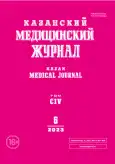Оценка эффективности остеопатического лечения пациентов с синдромом верхней грудной апертуры
- Авторы: Егорова И.А.1,2, Дюпин А.В.1,2, Данисько Р.С.3, Червоток А.Е.1,2
-
Учреждения:
- Новгородский государственный университет им. Ярослава Мудрого
- Институт остеопатической медицины им. В.Л. Андрианова
- Медицинский центр «Мотус»
- Выпуск: Том 104, № 6 (2023)
- Страницы: 828-834
- Тип: Теоретическая и клиническая медицина
- URL: https://journal-vniispk.ru/kazanmedj/article/view/257263
- DOI: https://doi.org/10.17816/KMJ568769
- ID: 257263
Цитировать
Аннотация
Актуальность. Синдром верхней грудной апертуры встречается у 2–8% людей в популяции и поражает пациентов наиболее трудоспособного возраста, преимущественно женщин.
Цель. Оценка эффективности комбинированного (медикаментозного + остеопатического) лечения пациентов с синдромом верхней грудной апертуры по сравнению с медикаментозной терапией.
Материал и методы исследования. В ходе рандомизированного исследования пациентки с признаками синдрома верхней грудной апертуры были разделены на две группы: основная группа получала комбинированное (остеопатическое + медикаментозное) лечение в течение 2 мес; контрольная группа получала только медикаментозное лечение (нестероидные противовоспалительные препараты, миорелаксанты, препараты тиоктовой кислоты) в течение 2 мес. Каждая группа состояла из 15 женщин в возрасте от 25 до 47 лет (основная группа — 36,31±7,33 года, контрольная группа — 35,18±6,76 года), длительность заболевания составляла от 6 до 18 мес (основная группа — 12,02±3,57 мес, контрольная группа — 11,07±3,97 мес). Группы были сопоставимы по возрастному составу и длительности заболевания. Для оценки эффективности проводимого лечения использовали динамику симптомов невропатической боли, стимуляционную электронейромиографию, динамику показателей остеопатического статуса. Данные представлены в виде среднего арифметического значения и стандартного отклонения. При анализе межгрупповых различий применяли непараметрический критерий Манна–Уитни (U-тест), при анализе внутригрупповых различий — непараметрический критерий Уилкоксона (W-тест). Оценку статистической значимости различия частоты остеопатических дисфункций и других частотных параметров до и после лечения осуществляли по критерию χ2 Пирсона. Критический уровень статистической значимости принимали за 5% (р=0,05).
Результаты. Сочетание остеопатического и медикаментозного лечения привело к разнице проводимости по правому локтевому нерву между группами (p=0,0003): в основной группе — увеличение скорости с 48,1±1,54 м/с до 61,0±3,34 м/с (p=0,0007), в контрольной группе — с 46,8±1,89 м/с до 50,2±4,85 м/с (p=0,0009). Анализ показателей шкалы NTTSS-9 (оценка симптомов невропатической боли) после проведённого лечения не показал разницы между группами (p=0,0941): основная группа — до лечения 14±2,14 балла, после лечения 2±1,4 балла (p=0,0003), контрольная группа — до лечения 15±1,95 балла, после лечения 6±2,80 балла (p=0,0007).
Вывод. В группе, получавшей комбинированное (остеопатическое + медикаментозное лечение), установлен больший прирост проводимости по локтевому нерву.
Ключевые слова
Полный текст
Открыть статью на сайте журналаОб авторах
Ирина Анатольевна Егорова
Новгородский государственный университет им. Ярослава Мудрого; Институт остеопатической медицины им. В.Л. Андрианова
Автор, ответственный за переписку.
Email: egorova.osteo@gmail.com
ORCID iD: 0000-0003-3615-7635
SPIN-код: 8356-2615
Scopus Author ID: 56542966000
ResearcherId: AAQ-1290-2021
докт. мед. наук, проф., зав. каф., каф. восстановительной медицины и остеопатии; директор
Россия, г. Великий Новгород, Россия; г. Санкт-Петербург, РоссияАртём Викторович Дюпин
Новгородский государственный университет им. Ярослава Мудрого; Институт остеопатической медицины им. В.Л. Андрианова
Email: adyupin@mail.ru
ORCID iD: 0000-0002-5881-2314
асс., каф. восстановительной медицины и остеопатии; преподаватель
Россия, г. Великий Новгород, Россия; г. Санкт-Петербург, РоссияРоман Сергеевич Данисько
Медицинский центр «Мотус»
Email: da.r@bk.ru
ORCID iD: 0009-0005-8689-6294
врач-остеопат
Россия, г. Ярославль, РоссияАндрей Евгеньевич Червоток
Новгородский государственный университет им. Ярослава Мудрого; Институт остеопатической медицины им. В.Л. Андрианова
Email: andro-med@rambler.ru
ORCID iD: 0000-0002-8559-982X
канд. мед. наук, доц., каф. восстановительной медицины и остеопатии; зам. директора по учебной работе
Россия, г. Великий Новгород, Россия; г. Санкт-Петербург, РоссияСписок литературы
- Харченко В.В., Лосева В.А. Синдром верхней апертуры грудной Интегративные тенденции в медицине и образовании. 2022;4:240–244. EDN: XHTCOG.
- Куцай Н.В., Головина Е.Р., Аджисалиев Г.Р. Современные методы лечения синдрома верхней апертуры грудной клетки. Инновации. Наука. Образование. 2020;(24):1933–1939. EDN: FQPRBA.
- Гаибов А.Д., Султанов Д.Д., Рахмонов Д.А., Нематзода О., Зугуров А.Х., Калмыков Е.Л. Результаты лечения сосудистых осложнений синдрома верхней грудной апертуры. Кардиология и сердечно-сосудистая хирургия. 2018;11(6):52–57. doi: 10.17116/kardio20181106152.
- Муин Р., Магомедов Р.К., Цуладзе И.И. Клинико-диагностические особенности в хирургическом лечении синдрома верхней грудной апертуры. Вопросы нейрохирургии им. Н.Н. Бурденко. 2015;79(2):55–63. doi: 10.17116/neiro201579255-63.
- Collins E, Orpin M. Physical therapy management of neurogenic thoracic outlet syndrome. Thorac Surg Clin. 2021;31(1):61–69. doi: 10.1016/j.thorsurg.2020.09.003.
- Panther EJ, Reintgen CD, Cueto RJ, Hao KA, Chim H, King JJ. Thoracic outlet syndrome: A review. J Shoulder Elbow Surg. 2022;31(11):545–561. doi: 10.1016/j.jse.2022.06.026.
- Jones MR, Prabhakar A, Viswanath O, Urits I, Green JB, Kendrick JB, Brunk AJ, Eng MR, Orhurhu V, Cornett EM, Kaye AD. Thoracic outlet syndrome: A comprehensive review of pathophysiology, diagnosis, and treatment. Pain Ther. 2019;8(1):5–18. doi: 10.1007/s40122-019-0124-2.
- Sanders RJ, Hammond SL, Rao NM. Diagnosis of thoracic outlet syndrome. J Vasc Surg. 2007;46(3):601–604. doi: 10.1016/j.jvs.2007.04.050.
- Balderman J, Abuirqeba AA, Eichaker L, Pate C, Earley JA, Bottros MM, Jayarajan SN, Thompson RW. Physical therapy management, surgical treatment, and patient-reported outcomes measures in a prospective observational cohort of patients with neurogenic thoracic outlet syndrome. J Vasc Surg. 2019;70(3):832–841. doi: 10.1016/j.jvs.2018.12.027.
- Warrick A, Davis B. Neurogenic thoracic outlet syndrome in athletes — nonsurgical treatment options. Curr Sports Med Rep. 2021;20(6):319–326. doi: 10.1249/JSR.0000000000000854.
- Cavanna A, Giovanis A, Daley A, Feminella R, Chipman R, Onyeukwu V. Thoracic outlet syndrome: A review for the primary care provider. J Osteopath Med. 2022;122(11):587–599. doi: 10.1515/jom-2021-0276.
- Patel K, Horak HA. Electrodiagnosis of common mononeuropathies: Median, ulnar, and fibular (peroneal) neuropathies. Neurol Clin. 2021;39(4):939–955. doi: 10.1016/j.ncl.2021.06.004.
- Остеопатия в разделах. Часть II. Руководство для врачей. Под ред. И.А. Егоровой. СПб.: СПбМАПО; 2017. 224 с.
- Остеопатия в разделах. Часть III. Руководство для врачей. Под ред. И.А. Егоровой. СПб.: СПбМАПО; 2014. 206 с.
Дополнительные файлы





